
Five Unseamly Gestures, cast iron, 2019
Paperwork is an exploration of denim and its central role as a ubiquitous fabric worn by the American worker alongside my desire to push the current two primary processes in my work, hand papermaking and iron casting, closer together. Using denim as a primary image and material, I question how a piece of clothing fashions worker identities. Bureaucracy, patriotism, the loss of unions, and the celebration of the blue collar worker is represented in a series of iron castings, cyanotypes of denim scans combined with archival imagery of the 1920 Blair Mountain Battle, some laser etched with first person accounts, and rust prints made directly from jean seams on large scale handmade paper. Paperwork explores labor and politics from the perspective of the individual and the collective.


Trophy I (left) cast iron, steel, clear enamel, 26”x13”x5” 2019 and
Trophy III (right) bronze, used alternator, steel, roughly 28”x14”x12”, 2019.
Trophy III (right) bronze, used alternator, steel, roughly 28”x14”x12”, 2019.
Paperwork began when I was cleaning out a closet and came across a dozen pairs of my old work jeans which I’ve since outgrown. I cut the interior denim fabric out of the jeans to use in papermaking and was curious about the resulting fabric shell. I took those seams and cast them in iron, pushing the brittle molten metal through a very thin space to create Trophy I. Trophy I, III, and IV are awards for the work performed by blue collar workers and toy with the false narrative of masculine glory won through physical labor. Trophy III was cast in bronze at Salem Art Works and could be considered the gold award. It is mounted to a used alternator and If you lightly touch it, it will spin and shine for you. Trophy IV is the bronze award, cast in iron, rusted and sealed with black wax to create a final rich brown, and supported by a concrete base while Trophy I is a silver, second place award welded to an altered i-beam base.


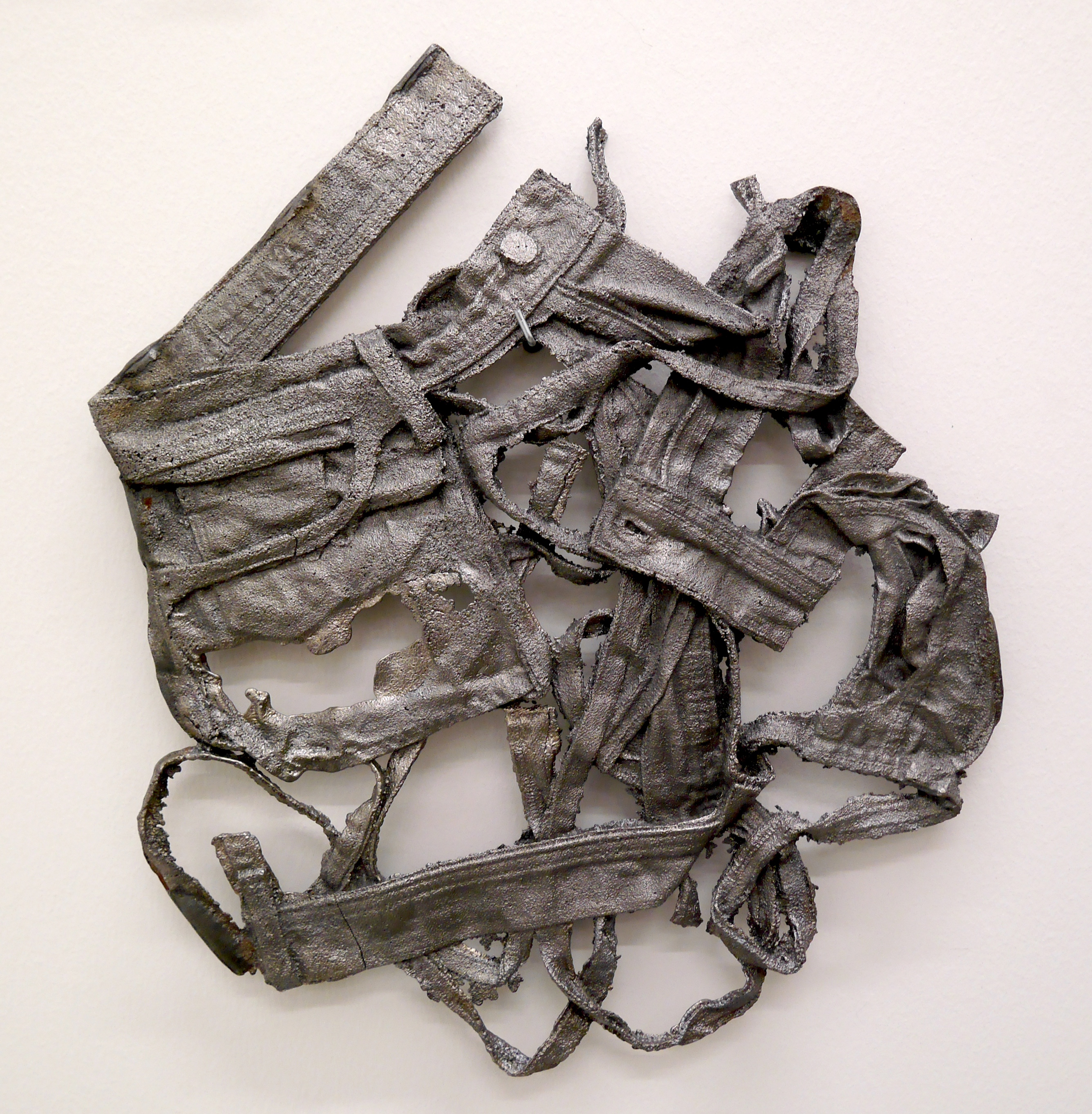


Five Unseamly Gestures, cast iron, dimensions variable, cast directly from size 12 jeans, 2019.
In Five Unseamly Gestures, I again made molds off of various jeans seams experimenting with how delicate or thin I could persuade the molten iron to be. I enjoy the moments of not knowing the full outcome of a process and allowed the material to choose its own final form. The title references gesture drawing and challenges the idea that women of a certain weight or shape are less seemly than others. I’ve taken pants that I’ve outgrown and cast them in an industrial material, making them both heavier physically while appearing energetic and floating visually. The two largest gestures were cast in Peoria at the First all Female Iron Pour in November, 2019.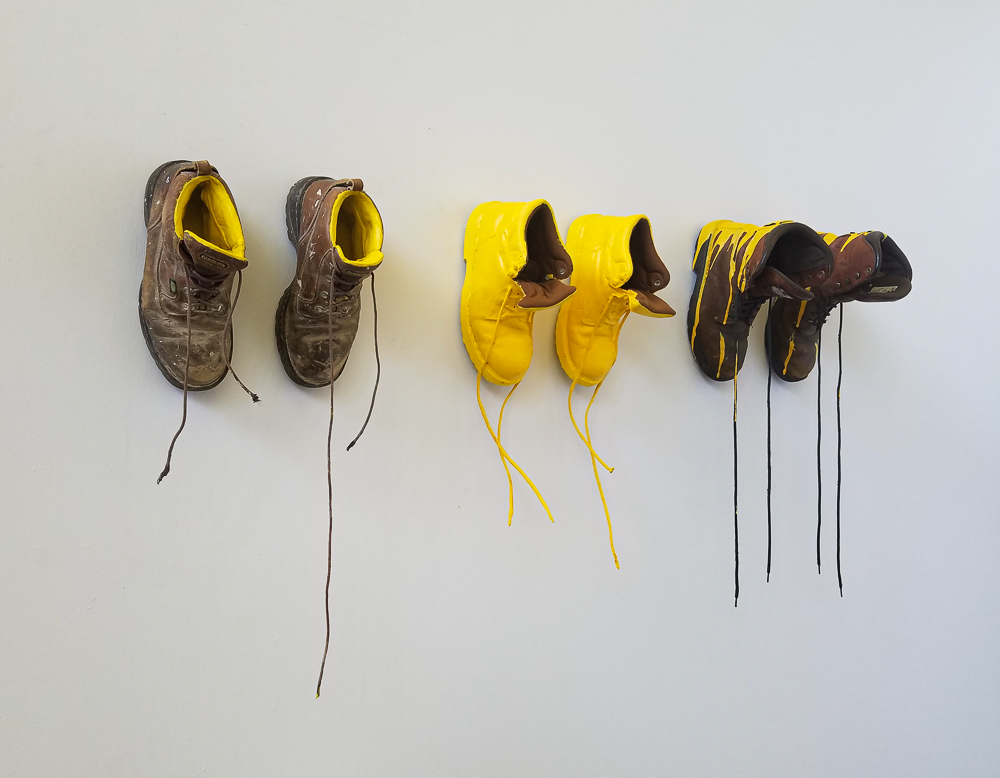
Tool Dipped Boots I, II & III, worn out women’s size 11 boots, yellow plasti-dip, 2013, 2014, 2018
In Tool-Dipped Boots, you see three pairs of my used work boots that I wore until they lost their utility. Now, they are used again as sculptures, artifacts of the labor they performed, cushioning my body, supporting my frame. Tool dip is traditionally used to coat the handles of tools if they’ve lost their grip; I’ve reclaimed the boots through the introduction of a new medium and again glorified the labor performed while in use. The tool dip adds a playful pop of color to the boots and memorializes their function. I will continue to add to my collection as each new pair of my work boots loses their initial purpose.
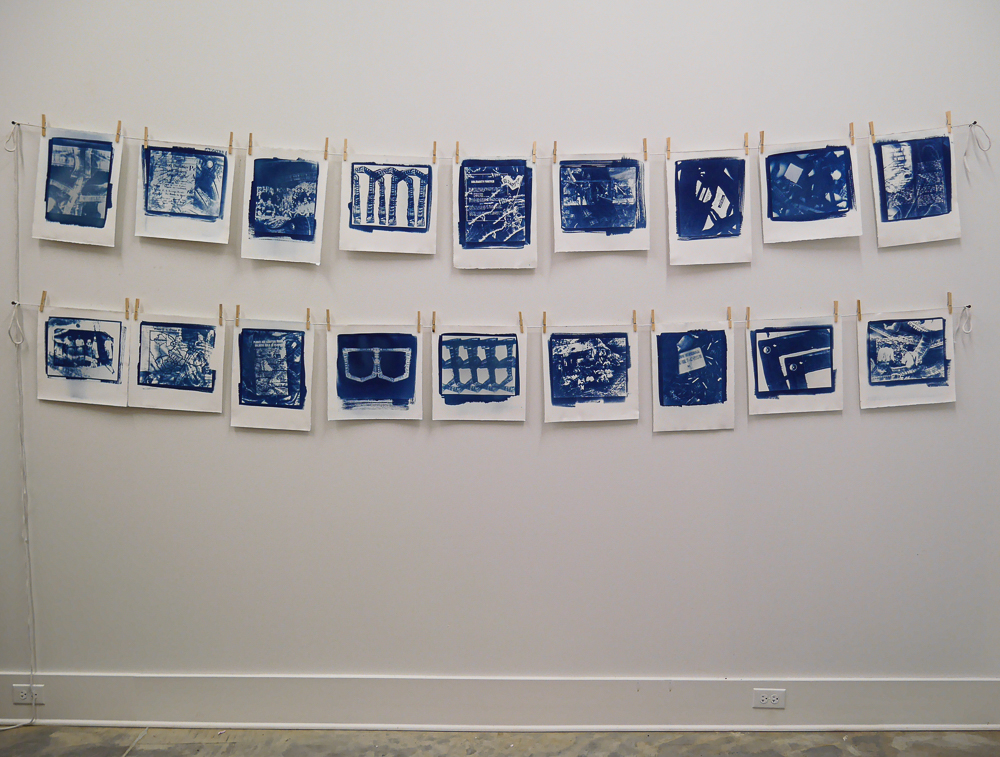


Material Histories, 20 cyanotypes on BFK Rives cotton paper some with laser etched text, clothesline, clothespins, nails, 2019-20
In Material Histories, a series of cyanotypes on BFK Rives cotton rag paper hang suspended with clothespins like laundry from a clothesline. Cyanotypes are an alternative photo process that rely on light sensitive iron particles suspended in a liquid and mixed with other chemicals. The liquid is painted on a surface and dried, then exposed to UV light (like the sun). I used digital negatives for this series that were edited in Photoshop and printed onto transparency paper using an Epson P800. I’ve combined images and news articles from the Blair Mountain Battle in 1920 with high resolution scans of the denim seams to create a new history and laser etched additional archival information found in the Matewan Oral histories on the West Virginia Archives and History website. The Blair Mountain Battle was the culmination of many years of struggle for the unionization of coal miners in West Virginia, Tennessee, and other Appalachian coal mining areas. 10,000 miners descended upon Logan County in West Virginia to fight back after tensions boiled over in the area between the local sheriff, Sid Hatfield, and the Baldwin Felts detective agents hired by the mining company to intimidate workers, leading to a shoot-out and massacre of the agents. The mining companies used their leverage to call in the National Guard to break up the battle and eventually bomb the miners from the air. The mining companies played dirty in order to make millions off of the backs of the working poor.
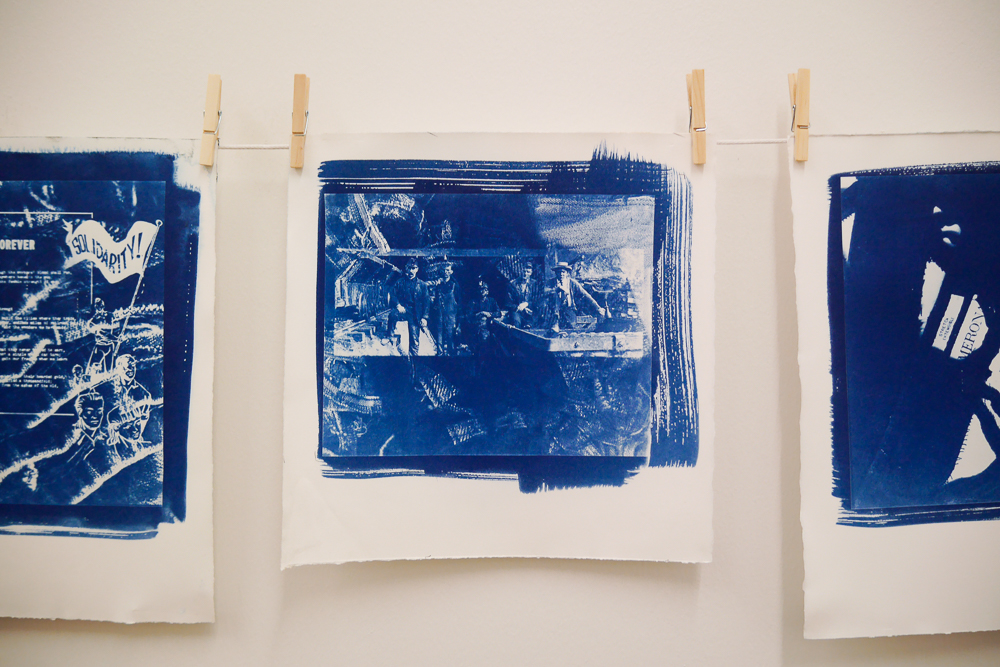
Using iron as a recording method, I’m triply celebrating these workers and a both proud and shameful moment in American history when a diverse group (blacks, immigrants, whites and their families) stood and fought together against tyranny and oppression. The laser etched quotes feature oral histories told by the miners’ children and lyrics from popular union songs from the time. The fonts are true to what was available in 1920. I’ve layering multiple histories of workers, their struggles, and images of denim to show the present reliance of imported goods to support our consumerist society and ultimately, the irony and inequality of the past and present visible through our shared use of denim and coal.
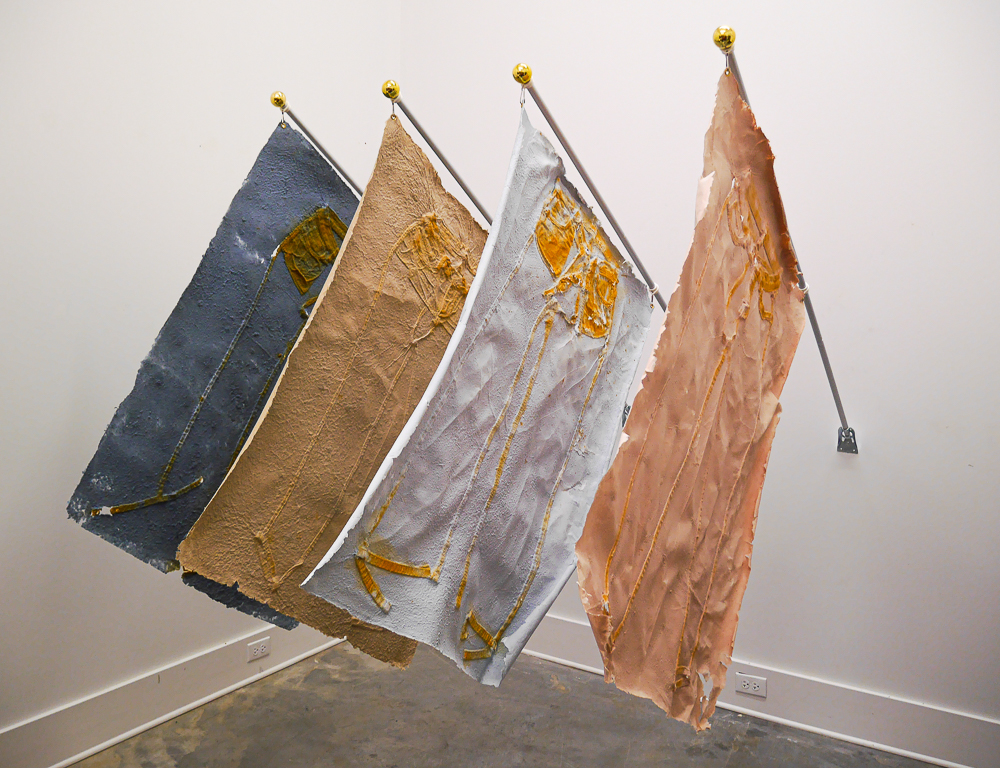

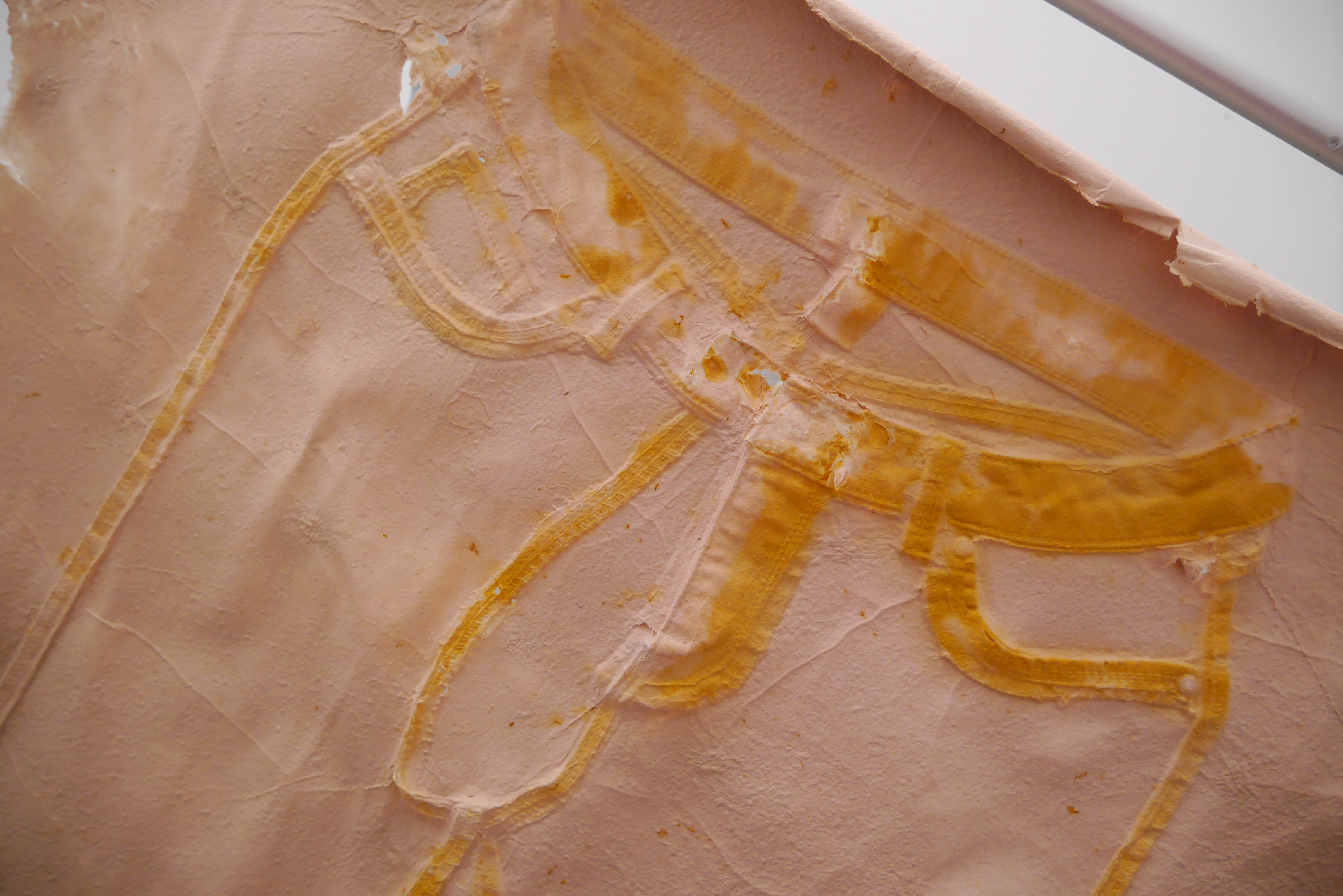
For Flags, rust prints on artist made denim paper, each flag is 3’x4’, 2019-20
Finally, For Flags and its companion piece, For Pockets, showcase four different denim pulps made from the same set of used work pants. The denim was cut from the center of each pair of pants and cooked with soda ash to soften the fibers. I then beat the fiber into a pulp in the paper studio using a Hollander beater. The colors result from the reactions of the soda ash and the original dyes in the jeans. I applied an iron coating to four sets of jeans seams and rusted them, as well as four pockets to use as a test. Using my custom built vacuum table, I suspended the pulp above the rusty seams and vacuumed out the water, creating the 3’x4’ sheets you see here hanging from flagpoles. For Flags is a representation of patriotism and the utilitarian turned functionless. The flags represent industrial advances, fashion, and our shared history of labor, both the individual and collective.


For Pockets, rust prints on artist made denim paper, each sheet is 8.5x11”, 2019-20
Jeans were invented in the United States by Levi Strauss and Jacob Davids in San Francisco to support the gold mining boom of the mid 1850s. The first truly American clothing was invented to be durable pants for miners, mechanics, roustabouts, farmers, and railroad workers. We’ve continued to wear jeans to this day, but 99% of denim is imported from Chinese or Mexican fast fashion factories. Ironically, a wholly American garment is now rarely produced in the States. Paperwork uses the past and present connotations of denim combined with the labor intensive processes of hand papermaking, and iron casting to call attention to industry, economics, our shared work to produce enough to support ourselves and our families.

Trophy II, cast iron, ~7”x2”x2”, 2019